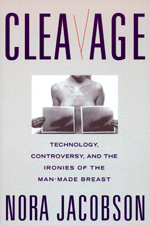

![]()
![]()

Nora Jacobson's Cleavage: Technology, Controversy and the Ironies of the Man-made Breast provided a timely answer to my confusion. A medical sociologist, Jacobson carefully maps out the history of breast implant technology from 1895 to 1990, paying special attention to the controversies, which emerged in the early 1990's over the safety of the devices. She shows how the meanings surrounding breast implants were constructed by specific actors - plastic surgeons, implants manufacturers, the FDA, the media, and consumer groups. She takes her reader through the early stages of breast augmentation when paraffin wax implants were used through the sponge implants of the fifties and sixties to the more recent silicone gel-filled implants. She shows how surgeons daringly grappled with imperfect technologies, embracing each innovation with enthusiasm, only to reject it later when it provided aesthetically or medically inadequate. She also shows how surgeons struggled with different notions of the female body. Originally, implants were treated as 'unnatural' - foreign bodies. Later, small breasts were pathologized and 'the psychology of the flat-chested woman' was born. In the interests of opening up augmentation surgery to new groups of women, implant candidates were reconceptualized as psychologically healthy women with an honest desire to feel better about themselves (p. 120). Jacobson shows not only how the implants and the candidates are socially constructed, but how the side effects and risks of the implants are constructed as well. 'Silicone disease' is in her view an intervention par excellence, reflecting the interests of the times in which they are constructed (p. 169).
Jacobson's aim is to go beyond the issue of why individual women want implants - an issue, which she feels has been the subject of most (feminist) research to date - and to focus instead on the technology itself. She shows how the technology of breast augmentation has shaped and been shaped by different groups and institutions. Breast implants are not simply a matter of individual choice, but the need has been created in a long history ('full of dark humor' and 'multiple ironies'). Jacobson makes a convincing case for taking a closer look at how this technology has changed and the shifts in the meanings, which have led to the acceptance but also the refusal of implants.
Jacobson has added an important dimension to the discussion of cosmetic surgery. I particularly liked her portrayal of the profession of plastic surgery and the surgeons' - belief that technology only moves ahead through innovation and mistakes as well as their unfailing conviction that their 'clinic experience' will serve as the ultimate arbiter in moments of indecision. I was sorry, however, that she didn't pay more attention to women as actors in controversies about breast implants. While I agree that technology cannot be reduced to individual choice, Jacobson could have paid more attention to women as advocates and as critics. In part, this omission is due to her - admitted - conviction that breast implants are ultimately 'absurd' - the product of a history which is - when all is said and done - 'just a little bit over the top' (p. 252).
Kathy Davis
University of Utrecht